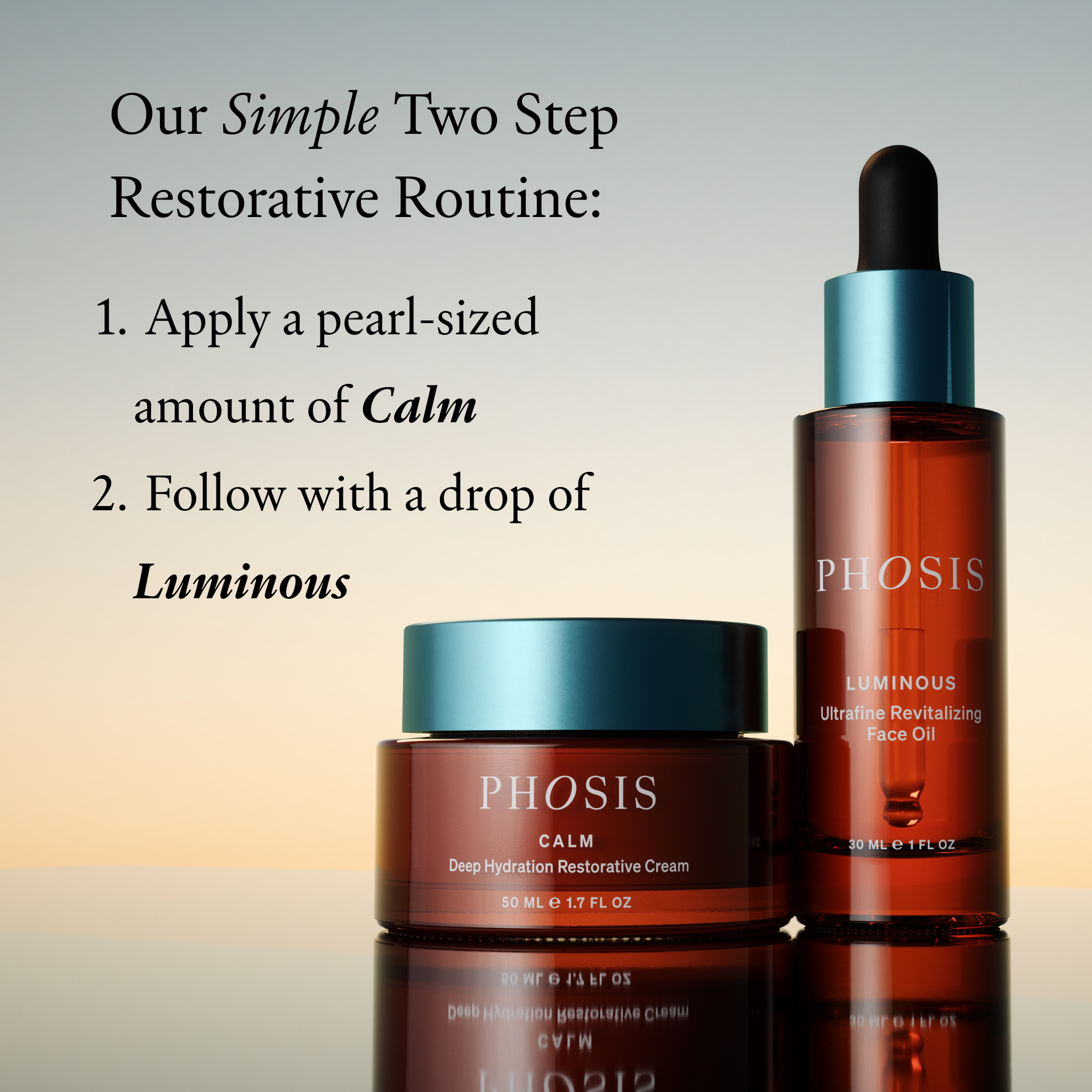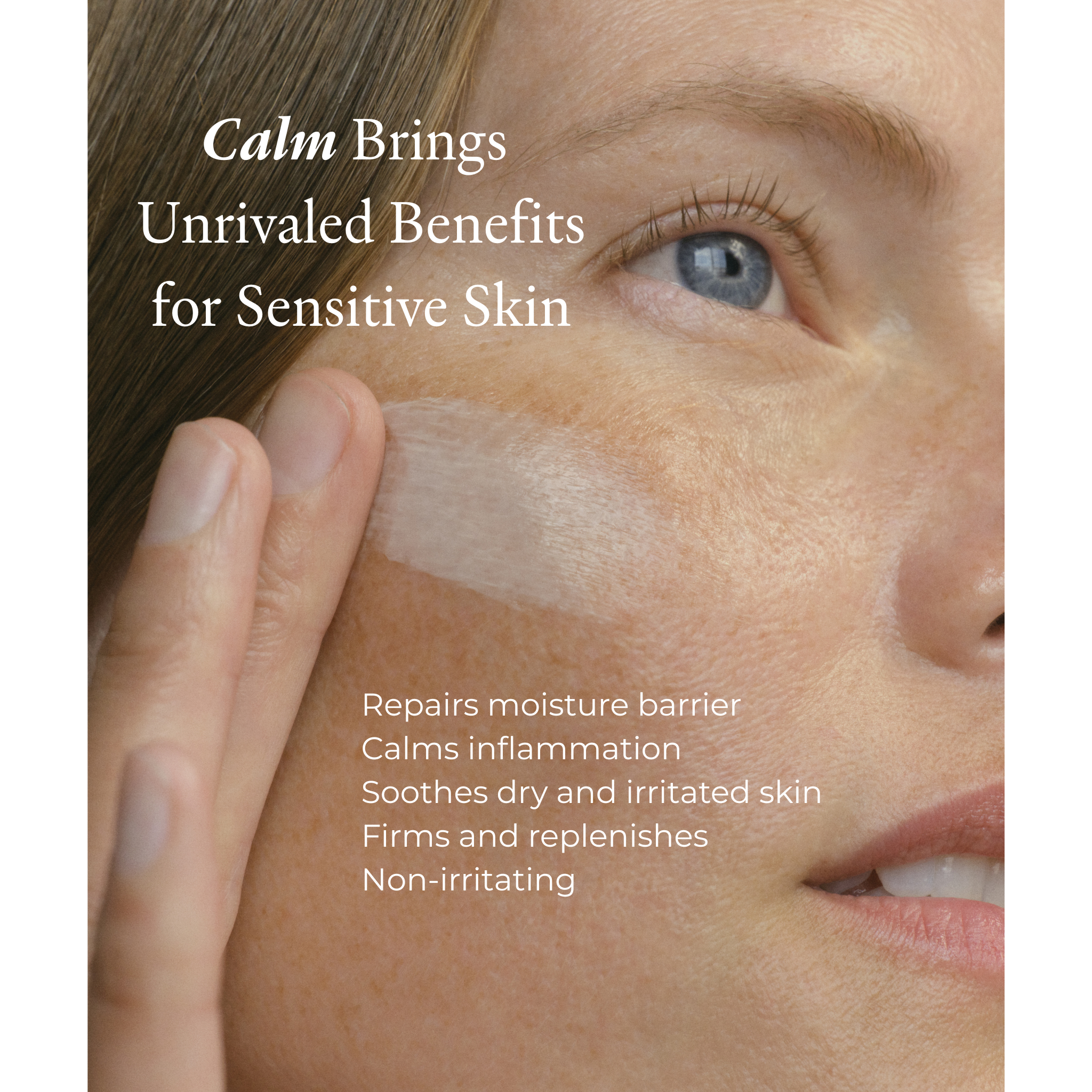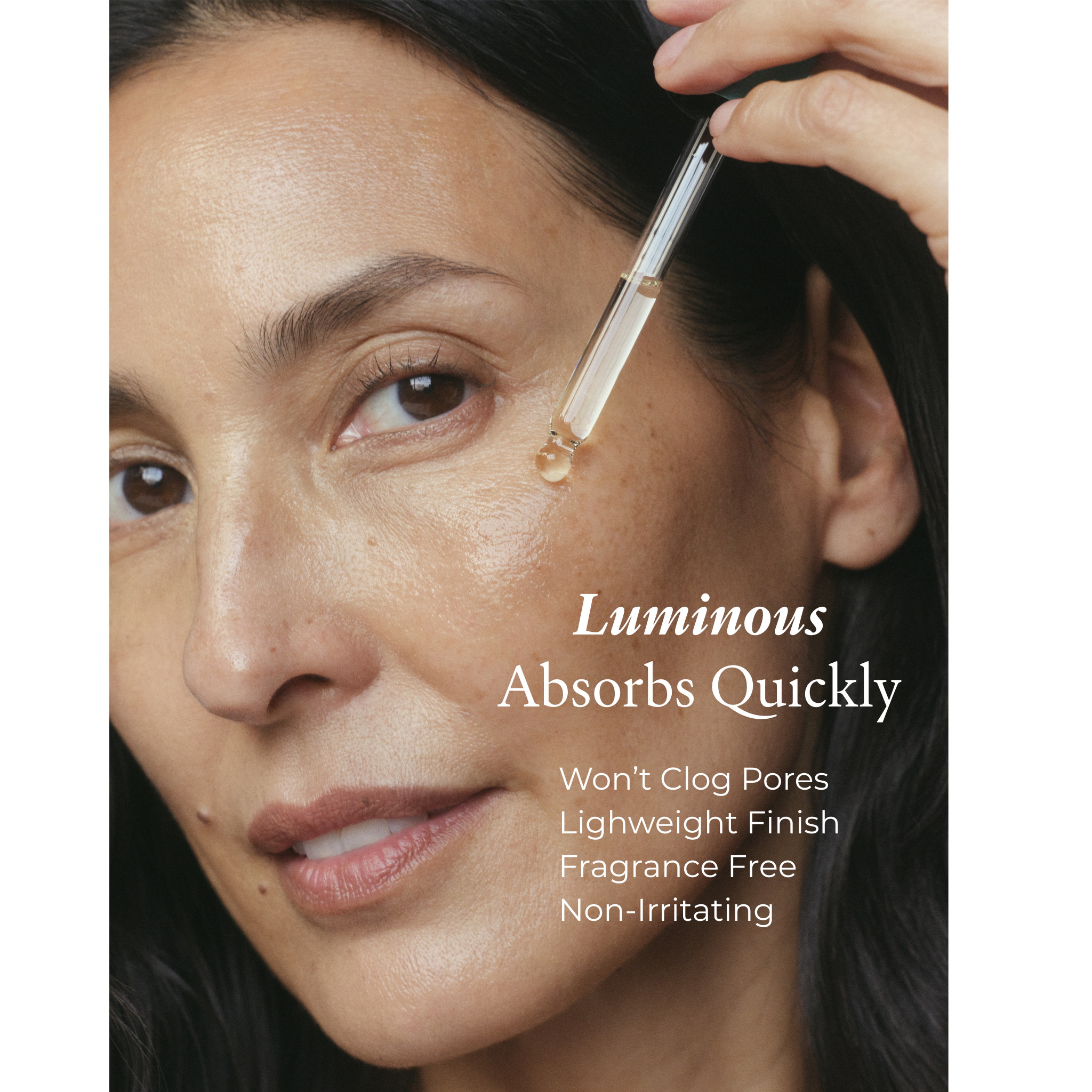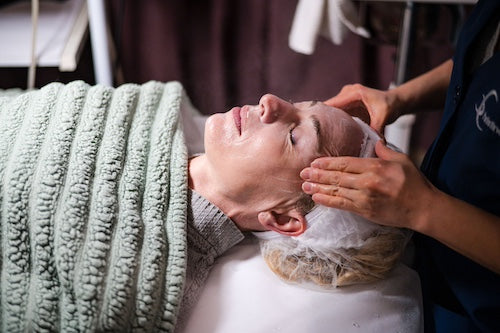Healthy, radiant skin starts with a strong foundation—and that foundation is your skin barrier. When it’s working well, your barrier locks in hydration, defends against irritants, and supports everything from glow to resilience. But when it’s compromised, your skin can become dry, dull, and reactive.
A damaged skin barrier is more common than you might think, especially during perimenopause, when estrogen levels drop and the skin produces fewer of the lipids like ceramides it needs to stay protected. The good news? Your barrier can be repaired with the right support.
In this guide, we’ll explore the science behind skin barrier function and exactly what to do if your skin is feeling out of balance.
What is the skin barrier?
Your skin barrier is your skin’s built-in strength—its way of holding the good in and keeping the bad out. Technically called the stratum corneum, it’s the outermost layer of skin, made up of cells and lipids stacked together like bricks and mortar. Its job? Simple, but essential: retain moisture, block irritants, and keep your complexion calm, smooth, and resilient.
When your barrier is healthy, your skin tends to behave— it looks glowy, hydrated, and balanced. But when it’s damaged, everything feels off.
“I spend a lot of time treating patients who suffer from barrier dysfunction,” says Dr. Joseph Pietrangelo, a board-certified dermatologist in Memphis, TN. “Symptoms like dryness, rough texture, and redness are your skin’s way of telling you that you need to rethink your routine.”
Even your most trusted products can suddenly sting. That’s your skin’s quiet way of telling you it needs support.
How does a skin barrier become damaged?
While your skin barrier is remarkably smart, it’s also surprisingly sensitive. Every day stressors can wear it down without you even realizing it. Overdoing exfoliation, using a foaming or fragranced cleanser, layering too many active ingredients, or living in a dry or windy climate—all of these chip away at your skin’s natural defense system.
And then there’s perimenopause and menopause. As estrogen levels begin to dip, your skin produces fewer lipids—the very ingredients that help keep your barrier strong. What used to feel like “normal” skin might start to feel dry, reactive, or look dull, red, or rough. Your glow gets a little dimmer. This is when barrier repair becomes a necessity.
Skin barrier vs. moisture barrier — are they the same thing?
You’ll often hear “skin barrier” and “moisture barrier” used interchangeably to refer to the stratum corneum or outermost layer of your skin. Sources that refer to the “moisture barrier” are typically talking about the stratum corneum’s role in preventing water loss — dermatologists call this transepidermal water loss or TEWL. When you’re shopping for skincare products, look for either (or both) of these terms — they’re the same thing
15 ways to repair a damaged skin barrier
If your skin is sending SOS signals—tightness, redness, flakiness—it’s time to pause, reassess, and shift into repair mode. Here’s how:
-
Streamline your routine.
When your barrier is compromised, less is more. Strip your routine back to the essentials—cleanser, barrier repair cream, and sunscreen—so your skin can focus on healing without being overwhelmed by multiple actives.
-
Take a break from exfoliating.
Even gentle exfoliants like lactic acid or fruit enzymes can be too harsh for skin that’s red, flaky, or reactive. Give your skin a breather for at least a week, then slowly reintroduce actives one at a time if needed.
-
Use a non-stripping cleanser.
Harsh, foaming cleansers can disrupt your skin’s lipid layer and increase water loss. Opt for a gentle cream or oil-based cleanser that cleans without compromising your moisture barrier.
-
Reach for ceramides.
Ceramides are naturally occurring lipids that make up nearly 50% of your skin’s barrier. Using skincare products with added ceramides can help replenish what your skin loses with age and hormonal changes, especially in perimenopause. Dr. Pietrangelo agrees: “Numerous studies support the use of synthetic ceramides in order to improve skin barrier. I recommend creams containing ceramides frequently in my practice,” he says.
-
Seal with botanical oils.
Plant-based oils like jojoba, rosehip, and sea buckthorn mimic your skin’s natural sebum, locking in moisture and protecting the skin’s surface. They also deliver essential fatty acids that help rebuild barrier strength over time.
-
Avoid fragrance.
Fragrance—whether synthetic or “natural”—is one of the most common causes of skin sensitivity. When your barrier is already compromised, it’s best to eliminate potential irritants and go fragrance-free, says Dr. Pietrangelo.
-
Layer humectants.
Ingredients like hyaluronic acid and glycerin pull water into the skin and keep it there. Use a hydrating serum underneath your moisturizer to boost your skin’s water content and support elasticity.
-
Apply mineral sunscreen daily.
UV damage is one of the most significant threats to barrier health. Choose a mineral (physical) sunscreen with zinc oxide or titanium dioxide—they’re gentle on compromised skin and protect without irritation.
-
Sleep on a silk pillowcase.
Some experts suggest that silk creates less friction than cotton, which means less mechanical irritation for already inflamed or delicate skin. It also may help reduce moisture loss while you sleep.
-
Eat your omegas.
Omega-3 fatty acids—found in salmon, flaxseed, chia seeds, and walnuts—help reduce inflammation and strengthen the skin barrier. A balanced diet rich in healthy fats may improve skin texture and barrier resilience over time.
-
Hydrate—inside and out.
Drinking plenty of water supports your body’s overall hydration, but pairing it with topical hydration is key. Use humectant-rich serums and occlusive creams to lock that moisture inside the skin.
-
Skip hot showers.
Hot water strips the skin of its natural oils and can leave your barrier even more vulnerable. Stick to lukewarm showers and limit them to 10 minutes or less to protect your skin’s lipid layer.
-
Stress less.
Chronic stress triggers inflammation and slows your skin’s natural healing process. Try stress-reducing practices—like breathwork, walks, or journaling—to support your skin from the inside out.
-
Stick to pH-balanced products.
Healthy skin maintains a naturally acidic pH (around 4.7–5.5). Using high-pH products, like some soaps and foaming cleansers, can disrupt this balance and impair barrier function.
-
Give it time.
Skin barrier repair isn’t instant—true healing can take days or even weeks. Be patient, stay consistent, and remember: recovery happens when we care deeply, not when we do more.
What’s the difference between a barrier cream and a regular moisturizer?
While all moisturizers hydrate, not all of them help repair. That’s where barrier creams come in.
A typical moisturizer works by drawing water into the skin or preventing it from evaporating—great for a quick hydration boost. But if your skin barrier is damaged (think: tight, flaky, red, or reactive), a standard moisturizer often isn’t enough. You need something that actively helps rebuild your skin’s protective layer.
Barrier creams go a step further. They’re formulated with lipids like ceramides that mimic what your skin naturally produces to keep itself strong and resilient. These creams don’t just hydrate—they restore. They reinforce the skin’s structural integrity, reduce water loss, and protect against environmental stressors.
If you’ve ever felt like your usual cream “just sits there” or disappears within minutes, your skin may be craving the deeper, structural support a barrier cream can offer.
What's the best skin barrier cream?
When your skin barrier is compromised, the right cream can make all the difference. Look for formulas rich in ceramides, fatty acids, and antioxidants—ingredients that mimic what your skin naturally produces but may be struggling to hold onto, especially during perimenopause.
Our top recommendation? Calm Deep Hydration Cream, from Phosis.
Designed specifically for women in perimenopause and menopause, Calm delivers intense hydration and barrier repair in a fragrance-free, dermatologist-tested formula that’s as luxurious as it is effective.
Why it works:
-
Clinically proven to strengthen the skin’s barrier
-
Packed with five essential ceramides to replenish lipids lost during perimenopause
-
Rich in plant-based antioxidants like green tea, bisabolol, and calendula to calm redness and visibly reduce inflammation
-
Deeply moisturizes without clogging pores, making it suitable for sensitive, reactive, or acne-prone skin
-
Dermatologist-tested and safe for sensitive skin, with no added fragrance or essential oils
After an 8-week clinical trial:
-
97% of women said their skin felt smoother
-
93% of women had an improvement in radiance
-
84% of participants had an improvement in texture
-
82% of women had an improvement in suppleness
How to Use a Barrier Cream
Use Calm morning and night as the final step in your routine—or just before a mineral-based sunscreen during the day—to help rebuild a smoother, calmer, more radiant complexion.
And for a final layer of protection and glow? Add Luminous, our lightweight facial oil, as the last step in your evening routine or pressed gently over Calm during the day.
Formulated with a blend of jojoba, meadowfoam seed oil, prickly pear seed oil, and sea buckthorn oil, Luminous helps lock in hydration, soften skin texture, and support the microbiome. Together, Calm and Luminous create a nourishing seal that reinforces your skin’s barrier and leaves it looking luminous, not greasy.
It’s like wrapping your skin in silk—soft, protected, and beautifully supported.
Final Thoughts
If there’s one thing we’ve learned, strong skin isn’t about having a perfect routine. It’s about giving your skin what it truly needs—and knowing when to pause, replenish, and protect.
In perimenopause and menopause, your body is doing the hard work of transformation. Your skincare should meet that moment with the same level of care. Barrier repair isn’t just a trend. It’s the foundation of healthy, luminous skin—at every age.








